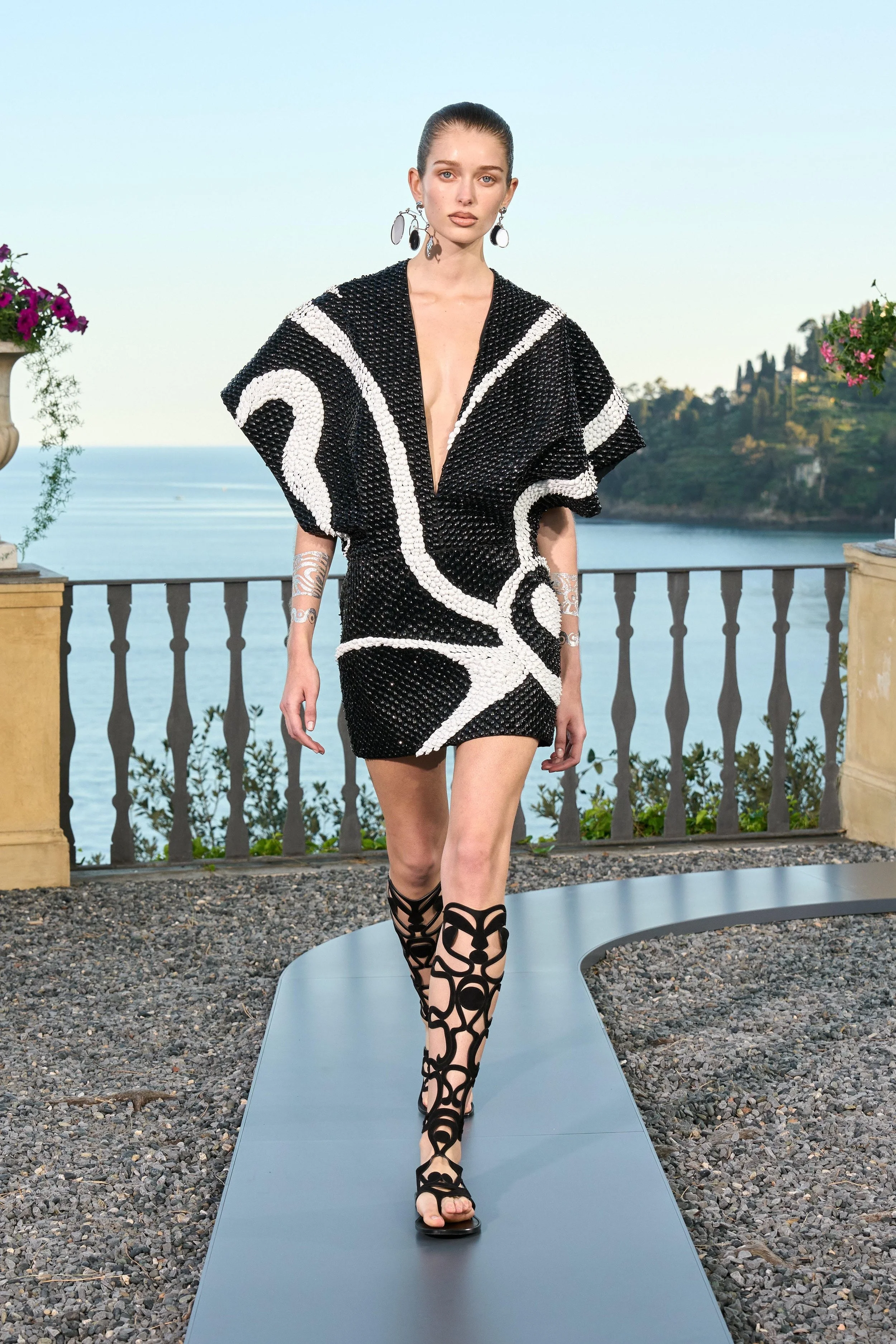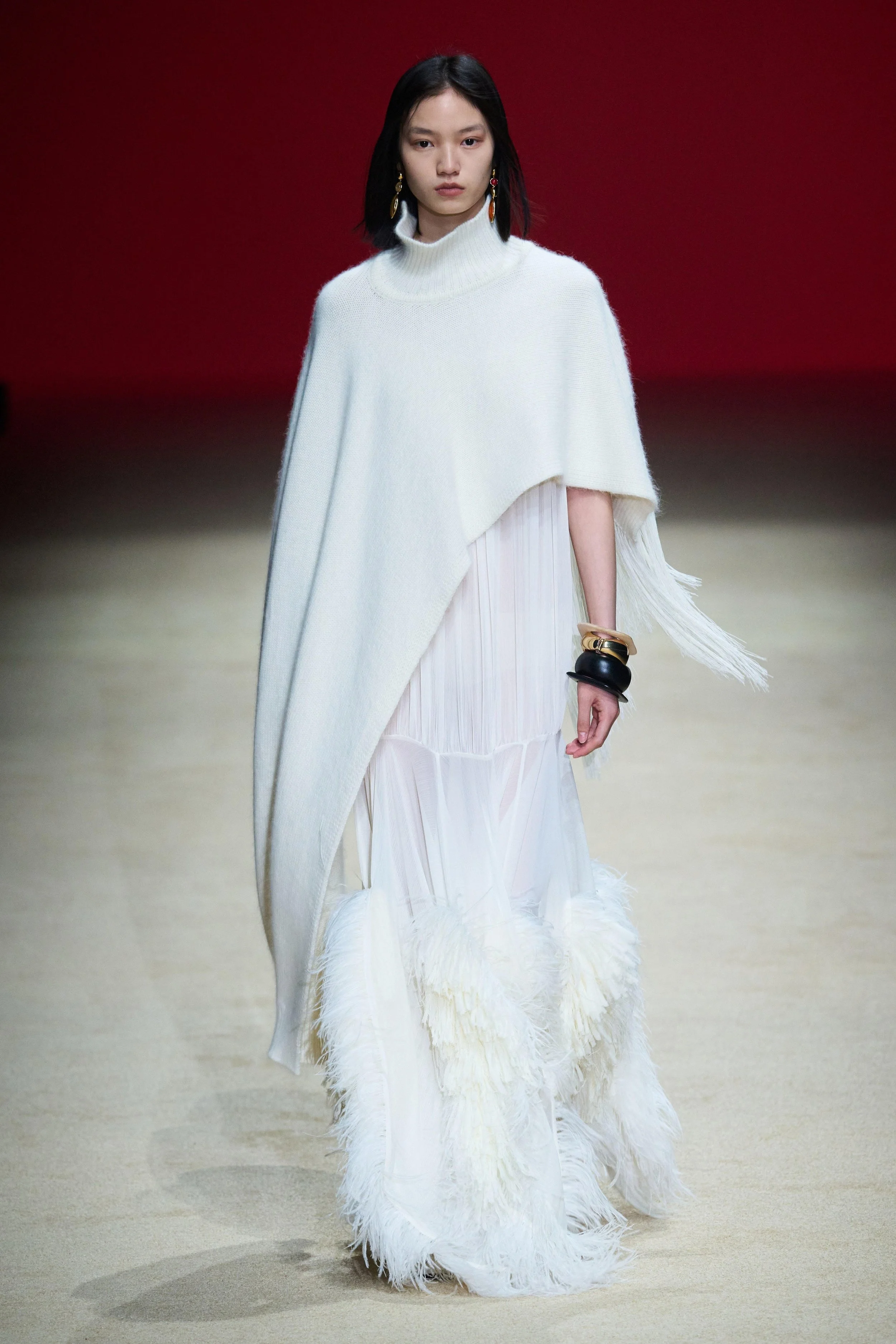The Sovereignty of Stillness: Inside the New Fashion Philosophy that Values Presence Over Performance
Let’s not waste time with metaphors: this look is unapologetically bold, fiercely controlled, and devastatingly seductive. Camille Miceli engineered a presence. What she sent down that Portofino runway was a declaration of what luxury fashion should be in 2025: smart, sharp, and completely in command.
The Sovereignty of Stillness: Inside the New Fashion Philosophy that Values Presence Over Performance
Fashion has never been louder—faster trends, bolder statements, more content. But some designers are choosing a different kind of power: the kind that doesn’t beg to be seen. Through restraint, presence, and radical clarity, they’re shifting the conversation from spectacle to sovereignty. Discover how Divyanshu Srivastava explores how designers like Maria Grazia Chiuri, Xu Zhi, and Camille Miceli are making stillness, control, and presence feel more powerful than spectacle:
A New Kind of Power
There’s a particular kind of silence that doesn’t shrink— it expands. That’s the silence Christian Dior conjured at To-Ji Temple in Kyoto, Japan, this season, when Maria Grazia Chiuri sent a sheer column of ombré chiffon gliding down the stone path, embroidered with branches that looked as if they had bloomed overnight from the fabric itself. In an era saturated with spectacle, this wasn’t absence— it was authorship. It was control.
Christian Dior Pre-Fall 2025
This dress didn’t whisper nostalgia or lean on borrowed exoticism. It wasn’t some East-meets-West fantasy set dressing Kyoto’s temples with European imaginations. It was something rarer: a conversation conducted with discipline, craft, and radical clarity. It stood still and made the world move around it.
And that act of standing still is perhaps the most radical gesture fashion can offer now. In a cultural moment addicted to acceleration, volume, and immediacy, the designers making the most lasting statements aren’t the ones shouting over each other. They’re the ones editing with ruthless precision, reclaiming authority over the body and its presentation, and reminding us that control— both aesthetic and emotional— is the real currency of modern luxury.
Xu Zhi Fall 2025
XuZhi Chen, in his Fall 2025 collection, arrived at the same revelation through a different vocabulary. His architectural poncho and sheer pleated dress didn’t seduce through chaos or embellishment. They seduced by anchoring presence. Here, control didn’t come from rigidity but from a command of texture, silhouette, and silence. Like Chiuri’s diaphanous column, Xu Zhi’s garments proposed a form of power that isn’t interested in approval. It simply exists— undeniable, unbothered.
Camille Miceli’s Pucci Spring 2025 collection offers yet another articulation of this philosophy. Known for resuscitating the house’s sun-drenched print legacy into something far more lethal, Miceli’s take is sculptural, monochrome, and surgical. A black dress slashed with strokes of white moves not like an invitation, but a command. The woman who wears it doesn’t seek the gaze. She redirects it.
Pucci Spring Summer 2025
Across these collections, a larger narrative emerges: fashion’s smartest minds are moving away from over-communication and toward presence. Away from spectacle and toward sovereignty.
The Return of Unattainability
If the early 2010s marked an era where relatability dominated— where personal style was democratised by social media, where every outfit had to be “approachable”— then the mid-2020s are witnessing the slow reemergence of the unattainable. Not unattainable through wealth, but through depth. Through intention.
And this shift isn’t merely aesthetic. It’s psychological.
We’re witnessing the exhaustion of availability— the way being perpetually visible, perpetually curated for public consumption, has hollowed out the emotional center of so much modern style. When everything is designed to be “liked,” when every surface screams for affirmation, where is there room left for mystery? For self-possession?
Designers like Chiuri, XuZhi, and Miceli are proposing an alternative: clothing that doesn’t offer itself up for consumption so easily. Clothing that holds something back.
Chiuri’s dress at Dior is emblematic of this. The sheer chiffon isn’t about exposing the body to be consumed. It’s about allowing the body’s silhouette to exist within the discipline of craft. About letting the embroidery — meticulous, asymmetrical, never sentimental— tell a quieter, truer story than any hashtag could capture.
Xu Zhi’s pleated gown, with its feather-dragged hem and ceremonial white palette, furthers this rejection of spectacle. Its transparency isn’t vulnerable in the Instagrammable sense— it’s sovereign. You are allowed to see, but not to claim.
Miceli’s Pucci woman makes the strongest case of all. She doesn’t soften herself for the viewer. She weaponises geometry — sharp shoulders, slashed prints, brutalist cuffs— as a means of reshaping the room around her. She isn’t nostalgic for past glamour. She is the future of it
The cumulative effect is a new kind of luxury: one rooted not in price tags or status symbols, but in psychological unavailability. In discipline. In refusal.
This isn’t the first time fashion has cycled through this instinct. In the 1990s, we saw minimalist designers like Jil Sander and Helmut Lang push back against the glitz of the 1980s with pared-back lines and precision tailoring. In the 1980s, Rei Kawakubo used “the body” not as a site for celebration but as a site for questioning. Alaïa mastered the body-con silhouette not to expose but to armour the wearer with their own skin.
What feels different now is that the power doesn’t have to come from hardness alone. Transparency itself— when wielded correctly— becomes armour. Vulnerability, when chosen, becomes a flex.
And that subtle evolution marks a larger cultural shift. As the world fractures further— politically, socially, environmentally— there’s a rising understanding that true power isn’t in domination. It’s in authorship. In presence. In the ability to hold complexity without broadcasting it.
It’s not an accident that in all three collections, the body is visible but never available. Sheer fabrics, slashed lines, and architectural volumes show the form without surrendering it. There’s a refusal here to translate the body into pure currency, into pure content.
The woman in Chiuri’s chiffon column doesn’t need to perform her desirability. The woman in Xu Zhi’s pleated dress doesn’t need to soften her edges to be allowed to exist. The woman in Miceli’s Pucci sheath doesn’t need to grin for the camera. She is the frame.
Stillness as Strategy
This resurgence of controlled stillness isn’t just about design philosophy. It’s about reimagining the wearer’s relationship to the world. About crafting garments that allow the wearer to own their space— without apology, without explanation.
It’s also a pointed rejection of the “contentification” of fashion— the way every look today is expected to perform virality on demand. These designers are making clothes that don’t care about being instantly understood. They demand time. Attention. Stillness.
And maybe that’s the point.
In a world that’s speeding toward collapse— technologically, ecologically, emotionally— the most radical thing you can do is stand still. Stand clear. Stand sovereign.
Chiuri’s cherry blossom embroidery isn’t just about mono no aware, the beauty of impermanence. It’s about knowing exactly what you are willing to reveal— and what you are not.
Xu Zhi’s ceremonial whites aren’t just about purity. They’re also about presence. About commanding attention without reaching for it.
Miceli’s black-and-white Pucci isn’t about nostalgia. It’s about reauthoring a history— stripping it of frivolity, sharpening it for the next chapter.
This is intelligent luxury. Not the kind that screams money. The kind that whispers power.
Fashion is always a mirror, but sometimes it’s also a map. Right now, the smartest designers aren’t just reflecting the world. They’re charting new territory. Territory where presence matters more than performance. Where the slow gaze matters more than the quick click.
In this new landscape, transparency isn’t about exposure. It’s about choice. Power isn’t about noise. It’s about knowing when not to speak.
And the future of fashion? It’s standing absolutely still— and daring the world to catch up.


